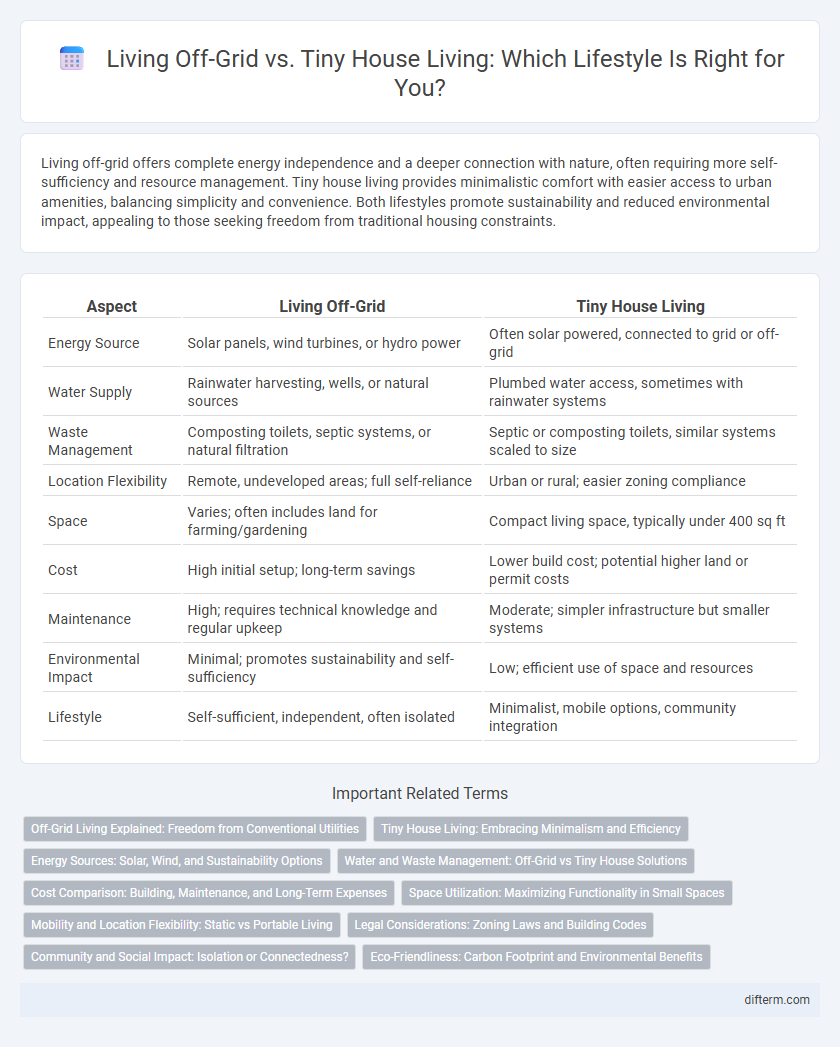Living off-grid offers complete energy independence and a deeper connection with nature, often requiring more self-sufficiency and resource management. Tiny house living provides minimalistic comfort with easier access to urban amenities, balancing simplicity and convenience. Both lifestyles promote sustainability and reduced environmental impact, appealing to those seeking freedom from traditional housing constraints.
Table of Comparison
| Aspect | Living Off-Grid | Tiny House Living |
|---|---|---|
| Energy Source | Solar panels, wind turbines, or hydro power | Often solar powered, connected to grid or off-grid |
| Water Supply | Rainwater harvesting, wells, or natural sources | Plumbed water access, sometimes with rainwater systems |
| Waste Management | Composting toilets, septic systems, or natural filtration | Septic or composting toilets, similar systems scaled to size |
| Location Flexibility | Remote, undeveloped areas; full self-reliance | Urban or rural; easier zoning compliance |
| Space | Varies; often includes land for farming/gardening | Compact living space, typically under 400 sq ft |
| Cost | High initial setup; long-term savings | Lower build cost; potential higher land or permit costs |
| Maintenance | High; requires technical knowledge and regular upkeep | Moderate; simpler infrastructure but smaller systems |
| Environmental Impact | Minimal; promotes sustainability and self-sufficiency | Low; efficient use of space and resources |
| Lifestyle | Self-sufficient, independent, often isolated | Minimalist, mobile options, community integration |
Off-Grid Living Explained: Freedom from Conventional Utilities
Off-grid living offers complete independence from conventional utilities by relying on renewable energy sources like solar panels and wind turbines, drastically reducing environmental impact. This lifestyle prioritizes self-sufficiency, utilizing rainwater collection systems and composting toilets to manage water and waste sustainably. Off-grid homes often incorporate energy-efficient designs and smart technology to optimize resource use, providing freedom from utility bills and centralized infrastructure.
Tiny House Living: Embracing Minimalism and Efficiency
Tiny house living prioritizes minimalism and efficiency by maximizing functional space and reducing clutter through smart design solutions. Embracing energy-efficient appliances, solar power systems, and sustainable materials allows tiny house residents to lower their environmental impact and utility costs. This lifestyle fosters intentional living, encouraging mindfulness and resourcefulness within a compact, affordable home environment.
Energy Sources: Solar, Wind, and Sustainability Options
Solar panels provide a reliable and renewable energy source for off-grid and tiny house living, harnessing sunlight to generate electricity efficiently. Wind turbines offer an alternative sustainable energy option, especially in areas with consistent wind patterns, complementing solar power systems. Combining solar and wind energy maximizes sustainability, reducing reliance on fossil fuels and increasing energy independence in eco-friendly lifestyles.
Water and Waste Management: Off-Grid vs Tiny House Solutions
Off-grid living relies heavily on autonomous water collection systems such as rainwater harvesting and well access, paired with composting toilets and greywater recycling to minimize waste impact. Tiny house living integrates compact, often modular water purification units and space-efficient waste management solutions like cassette toilets and portable greywater tanks. Both lifestyles demand innovative approaches to conserve water and responsibly handle waste, but off-grid setups prioritize sustainability and self-sufficiency while tiny houses emphasize efficiency and mobility.
Cost Comparison: Building, Maintenance, and Long-Term Expenses
Living off-grid typically involves higher initial costs due to investments in solar panels, water systems, and waste management, but offers significant savings on utility bills over time. Tiny house living often requires lower building expenses and reduced maintenance costs because of its smaller footprint and simplified systems. Long-term expenses for off-grid homes may increase due to system replacements, while tiny houses benefit from mobility and lower property taxes, making them cost-effective for budget-conscious lifestyles.
Space Utilization: Maximizing Functionality in Small Spaces
Living off-grid and tiny house living both demand innovative space utilization to maximize functionality within limited square footage. Multi-purpose furniture, vertical storage solutions, and modular design elements are essential for optimizing every inch of a compact home. Efficient spatial planning ensures comfort and practicality, transforming small living areas into highly functional environments.
Mobility and Location Flexibility: Static vs Portable Living
Living off-grid typically involves a static setup with permanent infrastructure, limiting mobility but offering self-sufficiency in remote locations. Tiny house living emphasizes portability, allowing residents to relocate easily and adapt to diverse environments without sacrificing comfort. This flexibility supports dynamic lifestyles, balancing freedom of movement with sustainable living solutions.
Legal Considerations: Zoning Laws and Building Codes
Zoning laws and building codes significantly impact both off-grid living and tiny house living, often restricting where and how these dwellings can be constructed. Off-grid homes may face legal hurdles related to utilities and land use, while tiny houses must comply with size restrictions, safety standards, and sometimes require adherence to traditional housing codes. Understanding local regulations is crucial for ensuring compliance and avoiding fines or forced relocation in either lifestyle choice.
Community and Social Impact: Isolation or Connectedness?
Off-grid living often entails physical isolation, limiting daily social interactions and community engagement, whereas tiny house living typically occurs within established or emerging neighborhoods fostering stronger social bonds and shared resources. Tiny house communities encourage collective activities, support networks, and sustainable practices, enhancing a sense of belonging and social responsibility. Conversely, off-grid lifestyles prioritize self-sufficiency, which can reduce social connectivity but increase environmental independence and personal resilience.
Eco-Friendliness: Carbon Footprint and Environmental Benefits
Living off-grid significantly reduces carbon footprints by minimizing reliance on fossil fuels through solar, wind, or hydro power, while tiny house living decreases resource consumption due to its smaller size and efficient design. Off-grid systems often incorporate rainwater harvesting and waste composting, enhancing sustainability and reducing environmental impact. Both lifestyles embrace eco-friendliness but off-grid living offers a more comprehensive approach to environmental benefits by promoting energy independence and zero-waste practices.
living off-grid vs tiny house living Infographic

 difterm.com
difterm.com